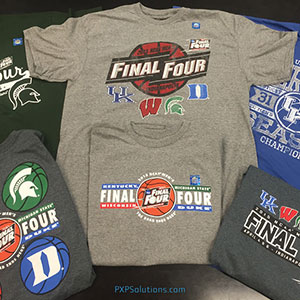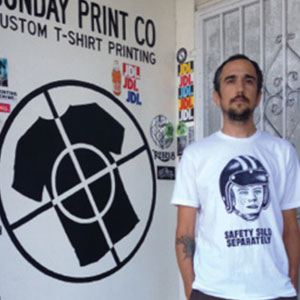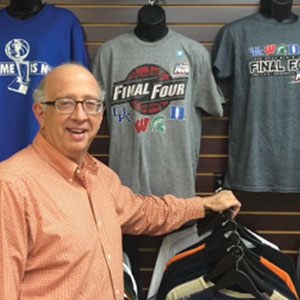Strategy June 30, 2015
The Burden of Large Orders
Large orders can swallow up a small decorator. Learn how to handle them carefully – and ultimately make them a part of your business.
Size is relative, especially when it comes to “large orders.” For a home-based screen printer with a small manual press, that might qualify as a few dozen garments, while a decorator with an automatic press might define large orders in the hundreds or thousands.
What remains true for both is the certainty that they have the time, resources and resolve to fulfill the order and not hurt their business. One-person operations already tax the owner to sell, manage and print by him or herself. “If you are principal, sales manager and printer, and you are always … running the machine, you risk taking business backwards,” says Andy Shuman, general manager of Rockland Embroidery (asi/83089).
Larger shops can similarly strain their resources and get mired in low-margin work that doesn’t merit the size of the order. The issue is compounded when business quickly picks up and owners have trouble turning customers away. “Sudden growth can sometimes hurt companies,” says Consultant Roy Marques of The MCN Group. “Larger orders are not necessarily more profitable, and the price you need to sell these larger orders can, at times, be a much lower margin. Competition for these larger orders can be brutal; a couple of cents can make a huge difference. If companies enter this marketplace they will need capital to support the purchase of these larger orders, and they need to be committed to scale up their production capacity.”
If decorators are not equipped to handle large orders on a consistent basis, the owners have to weigh their options, from subbing the work out to expanding their production capabilities. Answering these five questions will define how often a decoration business will be living large.
1. How Should a Screen Printer Handle Large Orders?
For small shops operating with a single manual, one large order can eat into press time, hamper efforts to generate business – and leave the owner with a serious case of tired arms.
“It is better to have the work and need more presses than to buy the press and hope for additional work.”
Bruce Jolesch, PXP Solutions (asi/297068)
Greg Tully’s choice for large orders is to contract them out. The owner of Tully Ink Screen Printing, a garage-based operation in Allston, MA, will sub out jobs of 200 pieces with two or more colors. He contracts with a father/son team based in Massachusetts that has an automatic press – a contact he found through a friend’s parent who has worked in the promotional products industry for 20 years. The screen printer is 30 miles outside the city from Tully Ink, which reassures Greg Tully that they’re not competing for the same customers. “They are reliable and produce great work,” Tully says.

PXP Solutions (asi/297068; circle 100 on Free Info Card) prints high-volume orders for hot markets like major sports and licensees, including the recent 2015 NCAA basketball Final Four.
Tully typically has one larger order per month that needs to be sent out for printing elsewhere – clients range from schools and specialty gyms to a clothing line and small startup company.
Quantifying a large order can depend on not only the number of employees and the equipment on-hand, but also the market the screen printer occupies. Los Angeles-based Sunday Print Co. typically handles orders within a range of 50 to 500 pieces, a sweet spot that wasn’t discovered by accident. Co-owners Tim Guza and Paul Caruso have maintained a focus on filling a niche for smaller jobs due to the wealth of competitors in the Los Angeles area. “You really have to base that decision on the type of client base you have,” says Guza, who founded Sunday Print Co. in 2006 from a garage with a four-color T-shirt press and an iMac. “One of the reasons we don’t have a huge demand for high-volume orders is that we’re located in a city with dozens of high-volume print shops. Most of the clients that come to us want a more personal experience, and typically need a quality product in a short timeframe. Since that’s become our niche, there’s really no reason to equip ourselves to print 5,000 to 10,000 shirt orders.”
2. How Should Decorators Stretch Their Production?
There will come a point, however, when decorators will want to grow their business and handle larger order quantities they might have originally turned away. The orders may be coming so consistently that decorators will know they need greater capacity; they’re no longer able to meet their current delivery schedule, or they sell more than they’re able to produce. Marques highlights this as a critical crossroad. “They should know their production capacity and use this metric to make realistic decisions on committing to customers,” Marques says. “Saying no is usually not an option so most companies will accept orders when they cannot effectively produce without adding overtime costs and shuffling orders that were properly scheduled and affecting those delivery dates.”
One solution is for decorators to stretch their capabilities with their current equipment. Marques recommends a change in production hours, such as four 10-hour days, which can work for those with a backlog of orders that is more than the decorator’s current capacity. “Usually this can increase your weekly production by 10 hours without paying any overtime,” Marques says. “Adding a second shift can also increase the production output, but finding the right person to manage a second shift can be difficult. Overlapping a shift with a partial second shift can also increase production, which you can staff with part-time help when needed.”
3. When Does It Make Sense To Add Equipment?
Purchasing additional equipment will add overhead expenses to a shop, but if large orders begin to arrive consistently, it will be worth it. “Last year we did end up having more than the average number of 500-plus piece orders,” says Guza, “so we recently added a second press to handle overflow. Now when we’re running a large job on our main press, we can knock out smaller orders at the same time without sacrificing quick turnaround times.” The studio also expanded to a larger space in Mid-City Los Angeles.
“Larger orders are not necessarily more profitable, and the price you need to sell these larger orders can, at times, be a much lower margin.”
Roy Marques, The MCN Group
There doesn’t always have to be a metric or hard rule for knowing when to expand. Guza says simply that the time is right “when orders are piling up or you have to turn orders away because you can’t meet deadlines.” A decorator’s location is another factor. “If you’re in an area where there are no high-volume printers,” he continues, “and you’re consistently getting inquiries for 1,000-plus piece orders, the lease on a new automatic is probably worth it.”
PXP Solutions (asi/297068), a large decorator based in Garland, Texas, is cautious when it comes to investing in equipment. “We would buy additional presses after we received a large volume contract, not before,” says Bruce Jolesch, president of PXP. “It is better to have the work and need more presses than to buy the press and hope for additional work.”
The degree of growth is important – perhaps adding a smaller machine makes more sense than adding a high-end item. “If you have three two-head embroidery machines and want a 12-head machine,” Shuman says, “what will this cost you? Do you have the business to support the growth?” In addition, owners need to be prepared for the hassles that come with growth. Not only will there be additional investment in equipment and supplies, but decorators will have to contend with additional issues like managing employees and handling HR concerns. True expansion is not a jump that should be made reluctantly. “First and foremost,” Shuman says, “you have to have passion to want to grow bigger.”
4. Is It Worth Handling Orders from Other Shops?
If a screen-printing business is successful over the years, growth is likely. The customer base will diversify, production capabilities will expand and equipment will be continuously added. In time, smaller shops will turn to you to handle those larger orders.
That’s what occurred at Rockland Embroidery. The shop first began in 1991 from the home of David Schlier, Rockland’s founder and president. He picked up whatever small embroidery jobs he could land locally. Over time Rockland developed contract work and the shop began stitching predominately for branded garment manufacturers such as Nike and Adidas. Then with the implementation of NAFTA, retail apparel manufacturers began moving their production, including decorating, out of the United States.
Where To Find Large Orders
Success will invite bigger business. Follow these tactics as well if you want higher-volume work.
You Can Start Small: “Look to grow at a manageable pace by doing more small to mid-size orders,” says Andy Shuman of Rockland Embroidery. “Get referrals from existing clients. Grow organically and then pick a niche market for larger orders.”
Keep Your Eyes Open: “There is no magic to finding special markets or companies that use large volumes of shirts. It changes frequently,” says Bruce Jolesch of PXP Solutions. “It could be the merger of two large Fortune 500 companies, or it could be a special gift by a corporation as a thank-you to their customers. Industries from technology, communications, food and beverage, industrial and others have used large volumes of shirts every year in the business.”
Stick to What Works: “There can be many ways to pursue larger orders, but companies should not stray too far from their core services or niches,” says Roy Marques of The MCN Group. “Adding more salespeople, exhibiting their services at specific trade shows, investigating large nonprofit organizations, and advertising agencies are a few options.”
Rockland had to shift its attention again. “We began to focus on contract work for promotional product distributors, small decorators with overflow work and screen printers,” says General Manager Andy Shuman. As the volume of contract orders grew, so did Rockland by adding more embroidery heads, picking up screen-printing equipment, relocating to a larger facility and hiring employees. Today Rockland operates from a 20,000 sq. ft. headquarters in Topton, PA with more than 240 embroidery sewing heads, six screen-printing presses and dozens of employees.
It’s a formula that works well, but it might not be the right one for every decorator. Tully faced a decision recently when he received a proposal to print contract work for a new print shop in the area. Tully rejected the decision, worrying that it would tie up his time and inhibit his ability to both service his retail customers and grow his business. He says the proposal reinforced the idea that he wants Tully Ink to be an end-user printer, and not a contract printer. “I feel there are more unique and up-close opportunities to print for customers, including on-site event printing,” he says. “I feel all too often printers make the transition from manual to automatic and forget to set themselves apart from the competition that has taken the same steps.” With a bank loan and an infusion of capital, Tully hope to realize his goal of expanding to a new location and bringing in employees to handle the technical aspects of the business. “My strengths are better suited in a business environment managing employees, quoting orders and speaking directly with customers,” he says.
5. How Big Can Large Orders Get?
Large orders are defined differently by the biggest of printers. As one of the top 1% worldwide in direct screen-printing capabilities, PXP considers jobs of 10,000 or more as large quantity with its four presses. “Our largest order last year was one order of 165,000 shirts,” says Jolesch. “We had about five weeks to produce them so we could work in the quantity with other time-sensitive orders.”
Many of the large orders PXP handles come from “hot markets,” which Jolesch explains as not only having significant quantity but also speed to market. Licensed apparel for major sporting events are an example. “We printed virtually all of the game night giveaway shirts when the Dallas Mavericks won the NBA Championship in 2011 as well as many shirts for a licensee after the championship game,” Jolesch says. “We have printed shirts for the NCAA Final Four both last year and this year, and after Ohio State won the College Football National Championship in Arlington, Texas in January, we printed over 6,000 shirts for a licensee for Dick’s Sporting Goods that shipped 24 hours after the game.”

Greg Tully, Tully Ink Screen Printing
Company: Single person with manual press
Large Orders: 200 and two colors or more
How He Handles: Subs it out to a screen printer 30 miles away with whom he has a friendly relationship.

Tim Guza, Sunday Print Co.
Company: Two co-owners and a part-time employee with two presses
Large Orders: Over 500
How He Handles: Added a second smaller press to handle overflow when larger orders come in.

Bruce Jolesch, PXP Solutions (asi/297068)
Company: 35 employees with four presses
Large Orders: 10,000 or more
How He Handles: Keeps staff available and blocks press time for large-scale “hot market” events.
Such a production feat requires a decorator to not only harness supplies such as extra inks, screens and equipment, but also to rally the employees. “When doing hot market printing you notify your staff in advance to make certain they are available and you have to block press time for it, and in many cases the next business day as well,” Jolesch says. “After a team wins a world championship, you might be using all four presses for 18 hours straight. You also have to give your staff a day off and work your normal business around these special events.”
Bottom line: Whether you aspire to big league order sizes or want to go from an average quantity of a few hundred to a thousand, you must be passionate and plan. Ramp-up the right way and your profits can too.
Tonia Kimbrough is a contributing writer for Wearables.
